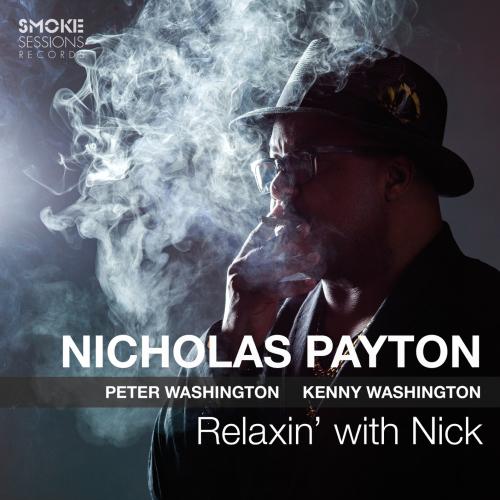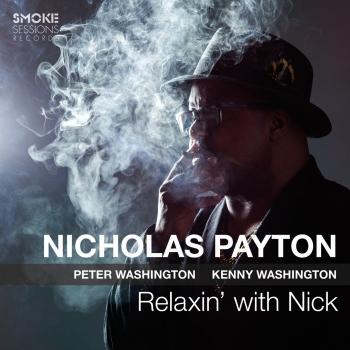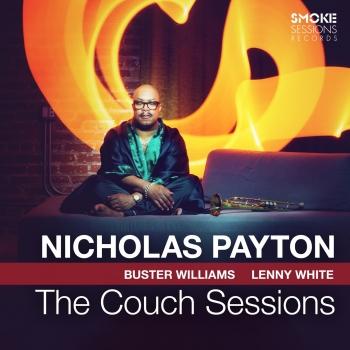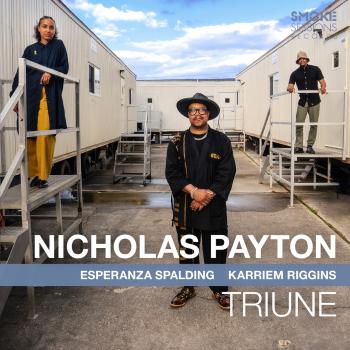
Relaxin' with Nick Nicholas Payton
Album info
Album-Release:
2019
HRA-Release:
25.10.2019
Album including Album cover
- 1 Relaxin' with Nick 07:39
- 2 C 05:00
- 3 El Guajiro 07:28
- 4 Stablemates 11:03
- 5 Eight 03:43
- 6 Jazz is a Four-Letter Word 09:54
- 7 Othello 08:26
- 8 Tea for Two 06:47
- 9 1983 07:57
- 10 F (for Axel Foley) 07:41
- 11 A 07:20
- 12 I Hear a Rhapsody 10:52
- 13 Five 14:38
- 14 When I Fall in Love 07:52
- 15 Praalude 02:19
Info for Relaxin' with Nick
When Nicholas Payton enters the recording studio, he uses that environment to the full extent of its capabilities, as he’s abundantly revealed on a series of groundbreaking releases that showcase his gifts as a producer as well as his virtuosic trumpet playing and multi-instrumental versatility. At the same time, Payton has evolved a singular approach to live performance, supplementing his breathtaking voice on the trumpet with his own accompaniment on piano and Fender Rhodes. On Relaxin’ With Nick, Payton is joined by the renowned rhythm section of bassist Peter Washington and drummer Kenny Washington– no relation, though their incredible chemistry highlights a bond as tight as family – for a stellar live set captured at Smoke Jazz & Supper Club.
Due out October 25 on Smoke Sessions Records, Relaxin’ With Nick brings the experience of witnessing Payton’s unparalleled live performances directly to the listener. The double album largely consists of Payton’s original compositions, alongside a few well-chosen standards, all evidencing the virtuosic musicianship and thrilling camaraderie discovered together on the club’s intimate stage in front of an enthusiastic audience.
The Smoke crowd plays an integral role in the album, as Payton was intent on representing the vibe of the space as well as the sound of the band, inspired by live classics like Ahmad Jamal’s At the Pershing: But Not for Me. “The particular way that Smoke is situated makes for even greater intimacy than your average club,” Payton says. “You can feel the atmosphere; you can feel the quiet. I want to hear glasses clinking, the murmur of conversation or the excitement of toe-tapping. All of those things lend themselves to the creative spirit and help set a mood.”
With that atmosphere established, the trio can feed off the energy in the room and spark a truly special, once-in-a-lifetime experience. That notion is only amplified by the fact that the weekend of concerts recorded for Relaxin’ With Nick represents this trio’s first performances together, though Payton has worked with each of the Washingtons in other contexts. The bassist and drummer share extensive experience together, most notably as members of the longstanding Bill Charlap Trio.
“At this point, their level of instantaneous dialogue is so intuitive that you have a ready- made camaraderie there,” Payton says. “The vibe they’re able to generate on such a consistent basis from having such a long association just feels so good. Once you connect with them it’s a beautiful thing, which is why they’re so sought after. Both of them have very strong and deep roots, but also a sensibility, a touch and a flair for whatever is current. Having a strong footing in the foundation and fundamentals, but also a willingness to be daring and to take risks, are equally important criteria to me.”
While always central to the sound of any ensemble, the rhythm section is particularly important to Payton’s unique approach given his peerless ability to double himself on trumpet and keys. While undoubtedly a crowd-pleasing feat of skill, the multi- instrumentalism is crucial for Payton’s deeply personal conception of his music, which has expanded beyond the confines of his horn to a more holistic notion of the overall sound.
“As my music became more personal, the idea of just taking trumpet solos and standing on the side of the stage seemed a bit stale and boring to me,” he explains. “Playing keys and accompanying myself allows me to be a part of the music in a more tangible way. It frees me up to play the music as I hear it, and puts me at the vanguard of creating a new technique in territory that is largely uncharted. It gives me a different edge.”
That edge manifests in a wide variety of styles and moods throughout Relaxin’ With Nick, from the gentle, buoyant swing of the title track to the slinky, blissed-out soul groove of a tune like “Eight,” to the bristling surge of “F.” Payton culls a few tunes apiece from his recent albums Letters and Numbers, with “C” performed as an elegant piano trio ballad, “A” at a joyous trot with Payton taking a thunderous turn on the piano before parrying his own trumpet solo on Rhodes. “Five” finds him alternating between the three instruments in a particularly tour de force outing propelled by the Washingtons’ muscular rhythms.
“El Guajiro” was originally recorded on Payton’s genre-blurring 2017 album Afro-Caribbean Mixtape. The tune is forged around a sample of the voice of master Cuban trumpeter Manuel “Guajiro” Mirabal, here launching the trio into a brisk, infectious cha- cha-cha. “Jazz Is a Four-Letter Word” is similarly built on the foundation of a vocal sample, here using a monologue by the iconic drummer Max Roach to opine on one of the trumpeter’s favorite subjects over a rock-solid beat. “1983” dips into a laid-back soul bag, pairing singing trumpet lines with shimmering keyboard textures, while “Othello” cedes the spotlight to Payton’s crooning skills, embedded in Kenny’s whispering brushwork and Peter’s eloquent bass oratory.
Payton opens Benny Golson’s classic “Stablemates” with a cosmically adventurous keyboard solo, ushering in the trio’s clamorous reimagining of the oft-recorded tune. Taken at a brisk tempo, “Tea for Two” feels anything but quaint as Payton’s trumpet rides the rollicking waves of the Washingtons’ urgent swing. “I Hear a Rhapsody” is passed through a prismatic deconstruction, while Payton takes to the microphone again for a heartfelt “When I Fall In Love,” before closing the set with a brief take on his own “Praalude,” from 2003’s Sonic Trance.
Given Payton’s rejection of the “listening room” experience of shushed patrons and reverent attitudes, Relaxin’ With Nick is just that: an opportunity to get comfortable with a genial host who hopes to entertain an audience, in a club or listening at home. “I feel honored that people choose to spend their evening with us with all the options people have these days,” he concludes. “There’s no greater compliment to me than people being able to hook up or party or converse in whatever fashion necessary. I’m happy to have my music be a part of fun and romance and the life force. To me, this is the point.”
Nicholas Payton, trumpet, piano, vocals
Peter Washington, double bass
Kenny Washington, drums
Nicholas Payton
Since 1994 when Nicholas Payton made his recording debut as a leader with From This Moment, the trumpeter has been lauded as a significant, top-tier voice in jazz. Even though he started out as a “young lion of jazz,” heralded as one of the new-generation guardians of the hard bop flame, Payton consistently committed himself to discovering his voice outside of the strict confines of that rearview mirror approach to the music.
While his jazz journey has taken him down many roads—from heritage artist to electric experimenter—the 34-year-old Grammy award-winning trumpeter arrives at a new plateau of jazz maturity with Into the Blue, his ninth album and his first for Nonesuch. It’s at once a nod to the past and a leap into the future. “It’s an amalgam of every recording I’ve done up until now,” says Payton. “As a musician, as an artist, you’re always trying to zero in on the bull’s eye as a means of becoming a better version of yourself. With Into the Blue, I’ve been able to find the kind of music that’s more inclusive of all of my life. The approach and the ideas of my music have become more singular, more cohesive. I had no agenda in terms of a specific genre or style, only to be true to who I am now.”
Into the Blue is a collection of ten tunes steeped in melody and groove that Payton says “embodies the sensibilities of beauty, elegance and simplicity” and delivers “danceable tempos.” He adds, “The true staples of jazz for me—the hallmarks of the music throughout its history—are love songs and the element of dance.” In addition to seven originals that range from the funky upbeat to the melancholic slow burn, the album includes two tunes by the trumpeter’s bassist/composer father, Walter Payton (the opening love song written for his wife, “Drucilla,” and his walking bass line-driven “Nida,” a celebration of his two sons, Nicholas and Dario) and a cover of the Jerry Goldsmith song “Chinatown,” from the movie of the same name. Joining Payton, who also sings on the hushed ballad, “Blue,” are acoustic and Fender Rhodes pianist Kevin Hays, acoustic bassist Vincent Archer, drummer Marcus Gilmore and percussionist Daniel Sadownick.
Instead of being recorded in a New York studio, Payton felt that it was fitting for the setting to be in his New Orleans hometown. “The focal point of the album is strength in subtly and understatement, a quiet revolution of sorts through love,” he says. “Even though the city has undergone tremendous change lately, it still represents a consistent foundation for me.”
Payton exhibits tonal clarity throughout, avoiding the bursts of clarion exhilaration often associated with the trumpet. “I wanted to keep my playing within a certain range,” he says. “I didn’t want to play too high or too low. I was going for the sweet register of the horn so that I could play with color and richness. The trumpet can be such a brassy, powerful instrument, but I wanted to focus more on the core of the sound by staying close to the middle.”
Born into a musical family (he remembers sitting under the piano while his father rehearsed with his band) and mentored by two Crescent City jazz masters (Clyde Kerr Jr. at the New Orleans Center for Creative Arts and Ellis Marsalis at the University of New Orleans), Payton was well-prepared to leap into the jazz fray when he emerged on the New York in the early 1990s. He impressed fellow New Orleans native and Jazz at Lincoln Center Artistic Director, Wynton Marsalis and was a regular in the early years of programming at the institution. Payton went on to put his own spin on Louis Armstrong-associated music on his sophomore CD, the appropriately-titled 1995 disc Gumbo Nouveau. While over the next several years, Payton continued to hone his craft working with such jazz legends as Doc Cheatham (on their Grammy Award-winning 1997 eponymous duo), Hank Jones, Elvin Jones, and Ray Brown, in 2003 he boldly moved beyond the straight-ahead. He shocked the jazz world with his adventurous CD Sonic Trance, an exhilarating plugged-in outing infused with elements of hip-hop, electronica, and effects-driven trumpeting.
“I wanted to make a shift to the other extreme,” Payton says. “I had been recording albums more in line with traditional jazz. Sonic Trance was all about breaking free from that. Now, I want to fuse those polarities, I'm seeking a more centered vision with Into the Blue.” He says that when he was in his 20s, it was as if he were living two lives—one being a young-lion torchbearer for making the music sound a certain way in 4/4 time with a swing feel, the other being at home with the musical experimentations of Miles Davis and John Coltrane, the electric fusion of Return to Forever and Weather Report, soul and R&B from Stevie Wonder to Anita Baker, and hip-hop.
The first CD he’s recorded since he entered his 30s, Into the Blue stands, Payton says, “most solidly in a place where I’m coming to terms with who I am. I’ve weeded out those things that don’t feel right for me. I’m not out to try to impress and I’m not worried that what I play is going to upset some people. I want to write and play music that speaks for me and means something to me, that I feel passionate about.”
Grooves are central to the project. “I was writing a lot from a groove first before melody,” Payton explains. “I was writing conga parts, real specific parts written out. I wanted that dance element that was there at the roots of jazz. I feel a lot of jazz has gotten away from that legacy.” He adds, “Whereas experimentation has its advantages, some things should always remain the same.”
Indeed, Into the Blue marks some impressive pushing on Payton’s part. He delivers a sweetened rhythmic brew on the Rhodes–driven “Let It Ride,” which he says exemplifies “the feel of this album…that’s the feeling that comprises everything I love in music.” “Triptych” extends the groove deeper as Payton soars elegantly above. “The Crimson Touch” is invigorated by the trumpet-piano interplay while “The Backwards Step” starts out with Payton’s lyrical rumination and develops into a relaxed vibe with a Latin spice. In a nod to the Big Easy, “Fleur de Lis,” with its swirling soundscape, is “a melody in the middle zone,” Payton says, “where we’re deliberately trying to play everything soft.” Into the Blue concludes with a surge in velocity, as Payton and co. take a percussive jaunt through “The Charleston Hop (The Blue Steps),” which offers the leader the opportunity to energize the trumpet in typical fashion. “I wanted to include at least one tune here that shows I still know how to burn out,” he says.
Into the Blue is produced by Bob Belden, known not only for his own groups but also for his integral role in issuing the Columbia/Legacy box sets of Miles Davis music. “Bob and I have been friends for years,” says Payton. “I go to his house when I’m in New York and he always turns me on to some new bootlegs he’s unearthed. I’ve always been leery of working with a producer, which is why I’ve produced most of my own albums. For Into the Blue, though, I thought that if I were to work with a producer that person would have to share a certain sensibility in music, someone who really hears and understands and has taste. Bob is the cat. It was great having another set of ears I trust for this project.”
“Payton’s clarion trumpet, as well as his genre-defying solos, stood at the center of the music making... Payton bent notes beyond recognition… No descriptive label or category could be affixed to Payton’s solos, which were as brashly original as they were technically imposing.” — Chicago Tribune
This album contains no booklet.









